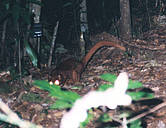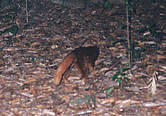  Frontal view of the mysterious animal (top). Back view of the same creature (bottom). © Stephan Wulffraat / WWF |
Mysterious carnivore found in Borneo rain forest
Unknown meat-eater discovered in Bornean jungle
WWF release
December 5, 2005
EDITOR’S NOTE: The discovery of this mysterious mammal was first announced in May 2005 by WWF. At that time it was called a “fox-like mammal”
2007 update: Borneo clouded leopard classified as a new species
Gland, Switzerland WWF researchers may have discovered a new, mysterious carnivore species in the dense, central forests of Borneo.
The animal, a mammal slightly larger than a domestic cat with dark red fur and a long, bushy tail, was photographed twice by a camera trap at night. This could be the first time in more than a century that a new carnivore has been discovered on the island.
However, WWF researchers have not yet established whether this is an entirely new species or if it is a new species of marten or civet cat, which looks like a cross between a cat and a fox.
They are hoping to be able to confirm more about the discovery by setting cage traps and catching a live specimen.
“We showed the photos of the animal to locals who know the wildlife of the area, but nobody had ever seen this creature before,” said Stephan Wulffraat, a biologist who is coordinating WWF’s research on this species. “We also consulted several Bornean wildlife experts, some thought it looked like a lemur, but most were convinced it was a new species of carnivore.”
WWF stresses that the strange animal, which also has very small ears and large hind legs, might remain a mystery for ever, if its habitat is not adequately protected.
Kayan Mentarang National Park in Kalimantan, where the carnivore was photographed, is located in the “Heart of Borneo”, a mountainous region covered with vast tracks of rainforest.
But plans announced by the Indonesian government in July to create the world’s largest palm oil plantation in this area would have a devastating impact on the forests, wildlife and indigenous people.
|
Related articles: Deforestation in Borneo. Kalimantan at the Crossroads: Dipterocarp Forests and the Future of Indonesian Borneo Borneo, the third largest island in the world, was once covered with dense rainforests. With swampy coastal areas fringed with mangrove forests and a mountainous interior, much of the terrain was virtually impassable and unexplored. Headhunters ruled the remote parts of the island until a century ago. In the 1980s and 1990s Borneo underwent a remarkable transition. Its forests were levelled at a rate unparalled in human history. Borneo’s rainforests went to industrialized countries like Japan and the United States in the form of garden furniture, paper pulp and chopsticks. Initially most of the timber was taken from the Malaysian part of the island in the northern states of Sabah and Sarawak. Later forests in the southern part of Borneo, an area beloging to Indonesia and known as Kalimantan, became the primary source for tropical timber. Today the forests of Borneo are but a shawdow of those of legend. New fox species discovered in jungle of Borneo Borneo’s peat lands going up in smoke China funds massive palm oil plantation in rainforest of Borneo 1,000 wild orang-utans poached a year says WWF |
The proposed scheme, funded by the China Development Bank, is expected to cover an area of 1.8 million hectares, equivalent to about half the size of The Netherlands.
WWF stresses that infertile soil and steep areas, such as those in the Heart of Borneo, prevent the development of oil palm plantations.
According to experts, it is not recommended to plant oil palm in areas 200 metres above sea level, because of low productivity. Most of the Heart of Borneo is between 1000 and 2000 metres high.
WWF’s Heart of Borneo initiative aims to assist the island’s three nations (Brunei, Indonesia and Malaysia) to conserve more than 22 million hectares of rainforest in the area.
“This discovery highlights the urgent need to conserve the unique forests in the Heart of Borneo, as this creature whatever it is hasn’t been seen since the pictures were taken and is therefore likely to occur in very low numbers,” said Stuart Chapman, WWF’s International Coordinator of the Heart of Borneo Programme. “What other secrets do these remote forests hold?”
It is extremely rare nowadays to discover a new mammal species of this size, particularly a carnivore, WWF says. The potential new species of carnivore in Borneo would be the first since the discovery of the Borneo ferret-badger in 1895.
This story includes a modified news release from WWF